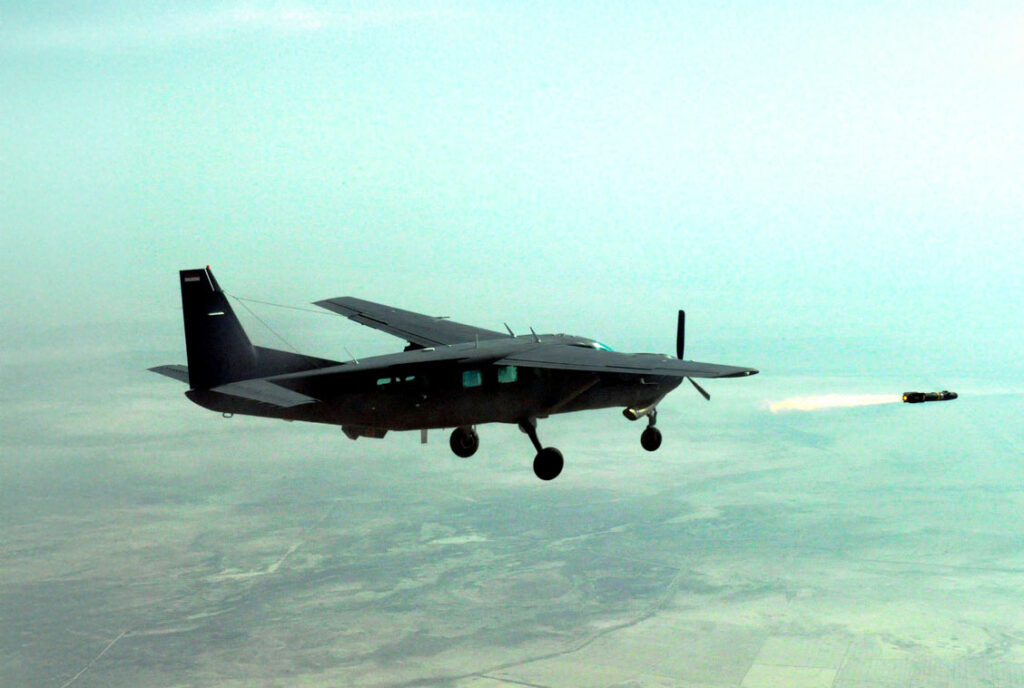Orbital ATK AC-208 Eliminator: an ISR and attack aircraft derived from the Cessna 208, armed with guided missiles and advanced sensors.
In brief
The Orbital ATK AC-208 Eliminator is a light attack and intelligence, surveillance, and reconnaissance (ISR) aircraft. It is built on the Cessna 208 Caravan airframe and is specifically modified for military operations. This aircraft is equipped with advanced ISR equipment and can carry laser-guided missiles, making it a versatile option for close air support and counterinsurgency missions. The AC-208 features rugged construction, suited for harsh environments, and can operate from short, unpaved airstrips. Powered by a single Pratt & Whitney Canada PT6A-114A turboprop engine, the aircraft can reach a maximum speed of around 200 knots (370 km/h) and has an operational range of 870 nautical miles (1,611 kilometers). The AC-208 offers both endurance and capability at a lower operational cost compared to heavier attack aircraft, making it a valuable asset for armed forces with limited budgets.

The Orbital ATK AC-208 Eliminator
The Orbital ATK AC-208 Eliminator was developed as a response to the growing need for a versatile and cost-effective light attack aircraft with ISR capabilities. During the early 2000s, the U.S. military and its allies faced increasing challenges in asymmetrical warfare, requiring aircraft that could perform both surveillance and precision strike missions. The need for a platform that could operate in rugged environments and perform multi-role tasks became evident. Orbital ATK, a defense contractor known for providing innovative aerospace solutions, responded to this requirement by modifying the Cessna 208 Caravan, a proven civilian utility aircraft, for military use. The resulting AC-208 Eliminator incorporated advanced sensors and weapon systems into the Caravan’s reliable airframe.
The AC-208 Eliminator made its first flight in the early 2010s, becoming operational soon after. Designed to provide effective close air support, ISR, and counterinsurgency capabilities, the AC-208 was developed with affordability and flexibility in mind. While it does not possess a NATO nickname, it has been widely adopted for its adaptability and effectiveness. The AC-208 quickly became known for its role in counterterrorism operations, especially in areas with challenging terrain where larger aircraft might struggle to operate.
History of the Development of the Orbital ATK AC-208 Eliminator
The development of the Orbital ATK AC-208 Eliminator was driven by the shifting nature of military conflicts during the early 21st century. Following the attacks of September 11, 2001, and the subsequent wars in Afghanistan and Iraq, U.S. military forces required an aircraft that could effectively support ground troops with real-time surveillance and targeted strikes against insurgent forces. As traditional combat environments gave way to asymmetrical warfare, military strategies emphasized the need for flexible, cost-effective solutions that could operate in various theaters, particularly in rugged and remote areas.
In response to this need, Orbital ATK (now a part of Northrop Grumman) launched a project to convert the civilian Cessna 208 Caravan, known for its reliability and low operating costs, into a multi-role military aircraft. The Cessna 208 had already proven itself as a rugged, versatile platform capable of operating from short and unpaved airstrips, making it an ideal candidate for modification. Orbital ATK focused on integrating ISR capabilities and weapon systems into the airframe, transforming the Caravan into a capable light attack and reconnaissance aircraft.
The AC-208 Eliminator was equipped with sophisticated ISR systems, including electro-optical/infrared (EO/IR) sensors and a laser target designator, which allowed it to locate and engage targets with precision. It was also modified to carry AGM-114 Hellfire missiles, providing substantial firepower in a compact and maneuverable platform. The AC-208 made its first flight in 2014, and by 2015, it was operational with the Iraqi Air Force, where it was deployed in counterinsurgency missions against ISIS.
Unlike more expensive attack aircraft, the AC-208 offered an affordable solution for countries with limited defense budgets. It allowed these nations to maintain air superiority and provide close air support for ground operations without the high costs associated with traditional fighter jets. The AC-208 has since been exported to other countries, including Lebanon and Afghanistan, where it has been employed in similar roles.
Design of the Orbital ATK AC-208 Eliminator
The design of the AC-208 Eliminator combines the simplicity and reliability of the Cessna 208 Caravan with advanced military technologies. The Cessna 208’s high-wing, single-engine design provided a stable platform for ISR and weapon systems. This high-wing configuration also enhanced visibility, essential for surveillance and targeting missions.
To accommodate its military role, the AC-208’s airframe was reinforced to support the additional weight and stress of mounted weapons. The aircraft retained its civilian turboprop engine, the Pratt & Whitney Canada PT6A-114A, which provides 675 shaft horsepower, enabling a maximum speed of approximately 200 knots (370 km/h) and a cruising speed of 160 knots (296 km/h). The PT6A-114A engine is known for its durability and efficiency, allowing the AC-208 to operate in remote areas with limited maintenance facilities.
The aircraft’s ISR capabilities are supported by a range of sensors, including EO/IR cameras that provide real-time video feeds to ground operators. This allows for efficient target acquisition and monitoring of battlefield conditions. The AC-208 can also be equipped with a laser rangefinder and laser target designator, enabling it to engage targets with precision-guided munitions.
While the AC-208’s turboprop engine limits its top speed and altitude compared to jet-powered aircraft, its design emphasizes endurance and fuel efficiency, providing a range of 870 nautical miles (1,611 kilometers) and an endurance of up to 6 hours. This makes the AC-208 ideal for prolonged ISR missions, although it may be at a disadvantage when facing faster or heavily armed adversaries.
The AC-208 can carry two AGM-114 Hellfire missiles on underwing hardpoints. The Hellfire missile is a laser-guided, air-to-ground missile widely used in anti-armor and close air support roles. Although the AC-208 lacks the payload capacity and speed of larger attack aircraft, its ability to deploy Hellfire missiles makes it a formidable platform for counterinsurgency operations. However, its reliance on a single engine means it lacks redundancy, which could pose risks during operations in hostile environments.
Performance of the Orbital ATK AC-208 Eliminator
The AC-208 Eliminator is powered by the Pratt & Whitney Canada PT6A-114A engine, a reliable turboprop engine with a maximum output of 675 shaft horsepower. This engine allows the AC-208 to reach a maximum speed of 200 knots (370 km/h) and cruise at a speed of around 160 knots (296 km/h). The aircraft operates comfortably at altitudes of up to 25,000 feet (7,620 meters) and has an operational range of 870 nautical miles (1,611 kilometers), with a fuel endurance of up to 6 hours, depending on mission payload and configuration.
In terms of speed, the AC-208 lags behind jet-powered attack aircraft, which can exceed speeds of Mach 1. However, its turboprop engine provides significant advantages in terms of fuel efficiency and operational costs, making it a viable option for prolonged ISR and counterinsurgency missions. The aircraft’s lower speed also enables better stability and control during surveillance and close air support tasks.
The AC-208 is outfitted with a range of advanced avionics and sensor systems that enhance its combat capabilities. Its EO/IR sensors allow for day and night operations, while the laser target designator enables precision strikes with the AGM-114 Hellfire missiles. With a maximum payload capacity of 3,670 pounds (1,665 kilograms), the AC-208 can carry a mix of ISR equipment and weaponry.
Despite its capabilities, the AC-208 has some limitations compared to other light attack aircraft. For instance, the Brazilian Embraer EMB 314 Super Tucano, another light attack aircraft, offers similar ISR and close air support capabilities but with a slightly higher maximum speed of 285 knots (528 km/h). However, the AC-208 remains competitive due to its cost-effectiveness, ease of maintenance, and ability to operate from shorter airstrips.
Variants of the Orbital ATK AC-208 Eliminator
The AC-208 Eliminator has been produced in various configurations to meet different operational needs. The primary variant is the ISR-focused AC-208B, which includes advanced EO/IR sensors, communications equipment, and the capability to carry Hellfire missiles. This variant is specifically designed for intelligence gathering and close air support, combining surveillance and strike capabilities in a single platform.
Another variant is the AC-208 Combat Caravan, which was developed with a heavier emphasis on weapon systems. While it retains the ISR capabilities of the AC-208B, the Combat Caravan can carry additional munitions and is often used for more direct combat roles. It has been employed by several air forces for counterinsurgency missions, particularly in the Middle East.
The C-208 Caravan ISR variant is a non-armed version of the AC-208, optimized solely for ISR tasks. It lacks the hardpoints for Hellfire missiles but includes enhanced sensor suites for reconnaissance and target identification. This variant is typically used in environments where direct combat is less likely, and the emphasis is on gathering intelligence and providing surveillance support.

Military Use and Combat of the Orbital ATK AC-208 Eliminator
The AC-208 Eliminator has seen extensive use in military operations, particularly in counterinsurgency and anti-terror missions. Its armament includes two AGM-114 Hellfire missiles, which allow it to engage armored vehicles, bunkers, and enemy personnel. The Hellfire missile, equipped with a semi-active laser guidance system, ensures precision targeting, making the AC-208 effective in urban and rugged environments.
The AC-208 was notably used by the Iraqi Air Force during the campaign against ISIS. The aircraft provided critical close air support to ground forces, striking ISIS positions and disrupting supply lines. In one mission, the AC-208 successfully eliminated an ISIS convoy, demonstrating its capability in targeting and neutralizing enemy assets. The aircraft’s ability to operate from smaller airstrips allowed the Iraqi Air Force to deploy it close to the front lines, increasing mission response times.
In addition to its use in Iraq, the AC-208 has been operated by the Afghan Air Force, where it was similarly employed in counterinsurgency missions. Afghan pilots were trained to use the aircraft for both ISR and attack roles, which proved valuable in mountainous terrain where traditional fighter jets might struggle. The AC-208 was also sold to the Lebanese Armed Forces, where it is used for border security and counterterrorism operations.
While the AC-208 has been effective in combat, it faces competition from other light attack aircraft, such as the A-29 Super Tucano and the Textron AT-6 Wolverine. These aircraft offer similar capabilities but have differences in speed, payload, and cost. Nevertheless, the AC-208 remains a popular choice due to its versatility and lower operating costs. It continues to be used by various air forces, and as of the latest reports, it remains operational with Iraqi, Afghan, and Lebanese forces.
Back to the Special Aircraft section